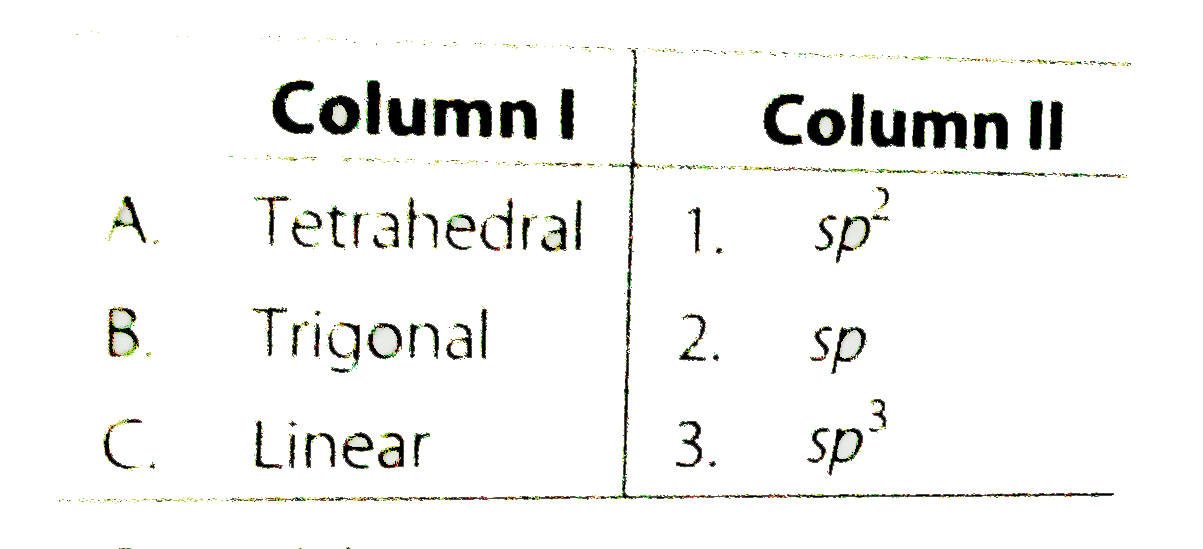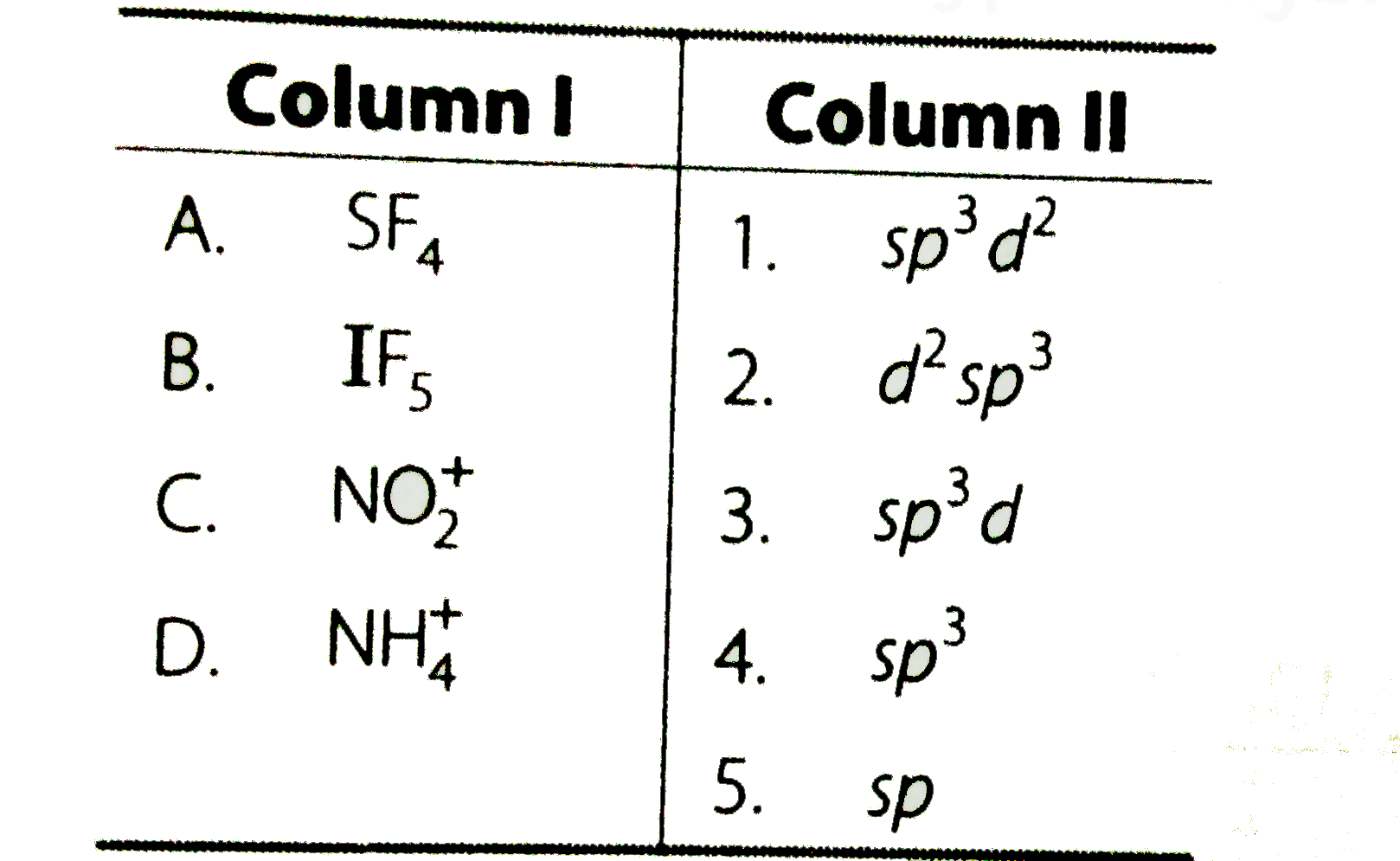Match the species in Column I with the type of hybrid orbitals in Column II.
Column IColumn II(i)BF3(a)sp3d(ii)H2O(b)sp2(iii)PCl5(c)sp3d2(iv)SF6(d)sp3
The correct Answer is:(i) → (b), (ii) → (d), (iii) → (a), (iv) → (c ).
To solve the matching of species in Column I with the type of hybrid orbitals in Column II, we will analyze each species and determine its hybridization.
1. Identify the hybridization of BF₃ (Boron Trifluoride):
- Boron has an atomic number of 5, with the electron configuration of 1s² 2s² 2p¹.
- In BF₃, boron forms three bonds with fluorine atoms, which requires it to use three sp² hybrid orbitals (one 2s and two 2p orbitals).
- Match: (i) BF₃ → (b) sp²
2. Identify the hybridization of H₂O (Water):
- Oxygen has an atomic number of 8, with the electron configuration of 1s² 2s² 2p⁴.
- In H₂O, oxygen forms two bonds with hydrogen and has two lone pairs, leading to sp³ hybridization (one 2s and three 2p orbitals).
- Match: (ii) H₂O → (d) sp³
3. Identify the hybridization of PCl₅ (Phosphorus Pentachloride):
- Phosphorus has an atomic number of 15, with the electron configuration of 1s² 2s² 2p⁶ 3s² 3p³.
- In PCl₅, phosphorus forms five bonds with chlorine atoms, which requires it to use sp³d hybrid orbitals (one 3s, three 3p, and one 3d orbital).
- Match: (iii) PCl₅ → (a) sp³d
4. Identify the hybridization of SF₆ (Sulfur Hexafluoride):
- Sulfur has an atomic number of 16, with the electron configuration of 1s² 2s² 2p⁶ 3s² 3p⁴.
- In SF₆, sulfur forms six bonds with fluorine atoms, which requires it to use sp³d² hybrid orbitals (one 3s, three 3p, and two 3d orbitals).
- Match: (iv) SF₆ → (c) sp³d²
Final Matches:
- (i) BF₃ → (b) sp²
- (ii) H₂O → (d) sp³
- (iii) PCl₅ → (a) sp³d
- (iv) SF₆ → (c) sp³d²
- Boron has an atomic number of 5, with the electron configuration of 1s² 2s² 2p¹.
- In BF₃, boron forms three bonds with fluorine atoms, which requires it to use three sp² hybrid orbitals (one 2s and two 2p orbitals).
- Match: (i) BF₃ → (b) sp²
- Oxygen has an atomic number of 8, with the electron configuration of 1s² 2s² 2p⁴.
- In H₂O, oxygen forms two bonds with hydrogen and has two lone pairs, leading to sp³ hybridization (one 2s and three 2p orbitals).
- Match: (ii) H₂O → (d) sp³
- Phosphorus has an atomic number of 15, with the electron configuration of 1s² 2s² 2p⁶ 3s² 3p³.
- In PCl₅, phosphorus forms five bonds with chlorine atoms, which requires it to use sp³d hybrid orbitals (one 3s, three 3p, and one 3d orbital).
- Match: (iii) PCl₅ → (a) sp³d
- Sulfur has an atomic number of 16, with the electron configuration of 1s² 2s² 2p⁶ 3s² 3p⁴.
- In SF₆, sulfur forms six bonds with fluorine atoms, which requires it to use sp³d² hybrid orbitals (one 3s, three 3p, and two 3d orbitals).
- Match: (iv) SF₆ → (c) sp³d²
- (i) BF₃ → (b) sp²
- (ii) H₂O → (d) sp³
- (iii) PCl₅ → (a) sp³d
- (iv) SF₆ → (c) sp³d²
Topper's Solved these Questions
- CHEMICAL BONDING AND MOLECULAR STRUCTURE BOOK - CBSE COMPLEMENTARY MATERIALCHAPTER - CHEMICAL BONDING AND MOLECULAR STRUCTURE EXERCISE - ASSERTION AND REASON TYPE QUESTIONS
5 Videos
- CHEMICAL BONDING AND MOLECULAR STRUCTURE BOOK - CBSE COMPLEMENTARY MATERIALCHAPTER - CHEMICAL BONDING AND MOLECULAR STRUCTURE EXERCISE - ONE WORD ANSWER TYPE QUESTIONS
10 Videos
- CHEMICAL BONDING AND MOLECULAR STRUCTURE BOOK - CBSE COMPLEMENTARY MATERIALCHAPTER - CHEMICAL BONDING AND MOLECULAR STRUCTURE EXERCISE - TRUE AND FALSE TYPE QUESTIONS
10 Videos
- CHEMICAL THERMODYNAMICSBOOK - CBSE COMPLEMENTARY MATERIALCHAPTER - CHEMICAL THERMODYNAMICSEXERCISE - Hots Questions
3 Videos
Similar Questions
Knowledge Check
sp3d2 hybrid orbitals are
AlinearBpentagonal bipyramidalCtrigonal bipyramidalDoctahedral
Match the species in Column I with the geometry/shape in Column II.
Column IColumn II(i)PCl5(a)Tetrahedral(ii)ClF3(b)Pyramidal(iii)NH+4(c)Bent T shape(iv)H3O+(d)Trigonal bipyramid
View SolutionMatch the shape of molecules in Column I with the type of hybridisation in Column II.

View SolutionMatch the species given in Column I with hybridisation given in Column II.
Column-IColumn-IIA.Boron in[B(OH4)]−1.sp2B.Aluminium in[Al(H2O)6]3+2.sp3C.Boron in B2H63.sp3d2D.Carbon in buckminster fullereneE.Silicon in SiO4−4F.Germanium in[GeCl6]2−
View SolutionMatch the species in Column I with the geometry/shape in Column II.
Column IColumn II(i)H3O+(a) Linear(ii)HC≡CH(b) Angular(iii)ClO−2(c ) Tetrahedral(iv)NH+4(d) Trigonal bipyramidal(e) Pyramidal
View SolutionMatch the species in Column I with the bond order in Column II
Column I Column II (i)NO (a)1.5(ii)CO (b)2.0(iii)O−2 (c)2.5(iv)O2 (d)3.0
View SolutionMatch the shape of molecules in Column 1 with the type of hybridisation in Column II.
Column IColumn II(a)Tetrahedral(i)sp2(b)Trigonal(ii)sp(c)Linear(iii)sp3(d)Trigonal bipyramidal(iv)sp3d
View SolutionMatch the species in Column I with the geometry/shape in Column II.

View Solution

